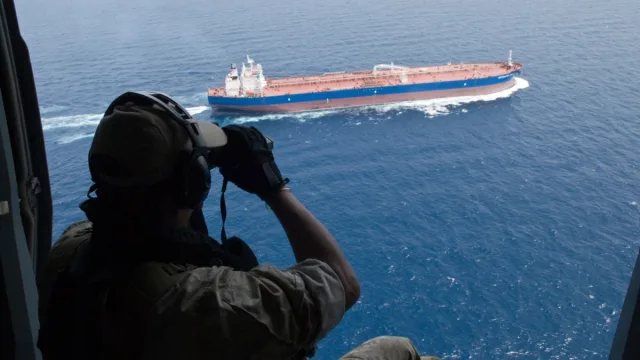Off the coast of Somalia, a sailor on board the French ship Sirocco observes two dhows…

Off the coast of Somalia, a sailor on board the French ship Sirocco observes two dhows through binoculars, establishing they are both bona fide fishing vessels.
If the coast of the autonomous region of Puntland is still home to pirates, they take to the seas a lot less frequently than they used to.
The presence of an international armada and the deterrents put in place by shipping companies have reduced piracy off the Somali coast and in the Gulf of Aden to practically nothing. But the threat is still very present.
According to the European anti-piracy fleet Atalanta, the last capture of a major vessel by pirates dates back to May 2012. Since then several vessels have been attacked or targeted but the pirates have not actually managed to seize any of them.
They have managed to seize a handful of dhows, with the aim of using them as mother ships for launching attacks on other vessels. But that booty pales into insignificance compared to vessels seized when piracy was at its peak: catches in those days included two supertankers, each transporting close on two million barrels of crude oil and a Ukranian cargo ship loaded with arms, notably tanks.
The Sirocco has not made any major catches either in its four months as Atalanta’s flagship — just five pirates arrested in mid-January on board an Indian dhow which they had seized in a vain attempt to board a tanker.
Since then the ships that make up Atalanta have confined themselves to patrolling, keeping a watchful eye on the zone and helping any vessels in difficulty. A South Korean fisherman, injured in a fishing accident underwent surgery on one of Atalante’s vessels.
“The economic model of piracy has been broken,” explained Etienne de Poncins, the head of EUCAP-Nestor, a European Union mission whose aim is to beef up the capacity of the countries in this zone (Somalia, Djibouti, Kenya, Seychelles and Tanzania) and enable them to carry out surveillance of their own territorial waters.
– ‘The pirates are still there’ –
When Somali piracy was at its peak in 2011, the International Maritime Bureau (IMB) counted 237 attacks attributed to Somali pirates in the Indian Ocean, from the Somali coast across the Sea of Oman.
In 2013 the IMB recorded only five attacks, all of which failed.
“At sea the phenomenon is under control. But the pirates are still there. They can be seen on the coast,” warned de Poncins.
By arresting numerous pirates over the past few years, Atalanta and its allies — NATO, China and Japan, which have all deployed considerable means in the region, a shipping route crucial for world trade — have had a very dissuasive effect.
A raft of measures taken by the shipping sector have also contributed to the decline of piracy: the presence of armed guards on board, the use of barbed wire, an increase in navigation speeds, navigating as far away from the coast as possible.
Indeed experts note that pirates have never managed to seize a vessel protected by armed guards or sailing at a speed of more than 18 knots.
But such measures are expensive. The World Bank noted that “piracy imposed a hidden tax on world trade”.
“Piracy costs the global economy roughly US$18 billion a year in increased trade costs ? an amount that dwarfs the estimated $53 million average annual ransom paid since 2005,” the bank said in a 2013 report.
“It’s expensive, so the day when the shipping companies say ‘That’s enough’ the whole thing can kick off again quite quickly,” warned de Poncins.
And given that attacks are becoming rare, ship owners and captains are starting to let their guard down, EU Naval Force officials say, reporting that ships are again navigating at slower speeds and sailing closer to the coast in order to save fuel.
“We are becoming victims of our own success,” said Lieutenant Michael Quinn of Atalanta, adding however: “the conditions on the Somali coast have not changed and industry must not relax”.
The EU Naval Force’s mandate applies only to the sea; it is not authorised to launch land attacks on the pirates who still control, notably in Puntland, large sections of the Somali coast.
Clan militia, pirate networks and criminal gangs share power in this country deprived of an effective government since 1991.
The fact that Somali pirates control the coast means they can bring their booty ashore, complete with cargo and crew, making rescue operations very difficult.
The mission of EUCAP-Nestor, which complements that of Atalanta, is therefore to “go ashore and train coast guards so that the countries of the region can be in a position to manage and control their maritime waters, but also to help them put legislation in place,” de Poncins said.
AFP





